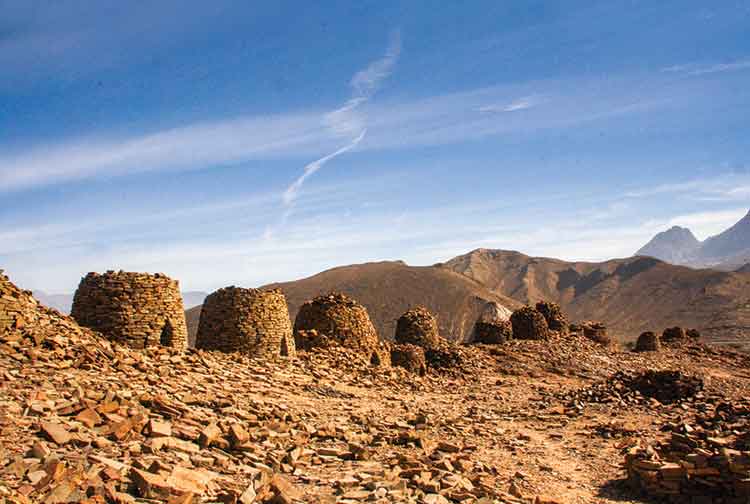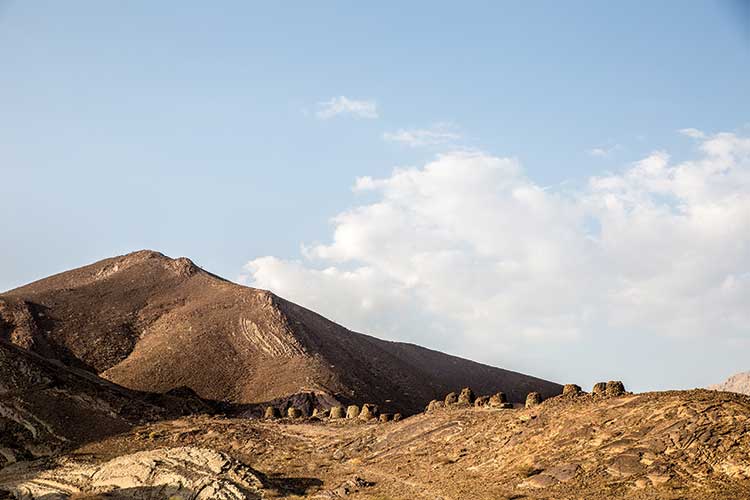Located about 25kms from Ibri, the ancient grave sites of Bat are a big lure for archaeologists looking for a tryst with times past. The intrinsic arrangement of stones is beguiling, creating a sense of awe and wonder among even lay visitors. There is a kind of rugged romanticism about this place that is at once awe-inspiring and haunting. Neatly rounded from the base and narrowing at the top, they present an assemblage of smooth polished stones. Called ‘beehives’, these tombs reflect a peculiar style of construction; they are built up by neatly stacking soft flat stones which occur in the vicinity of this place.
These ancient grave sites of Bat have been the focus of international attention for a while now. In the early 1970s, a team of Danish excavators under Dr. K. Frifelt discovered the heritage settlement in Bat. This mission was later followed by more teams from England and Germany who joined in the excavation efforts. Pottery and rock pieces, similar to the ones found in the cemeteries of Um AnNar Civilisation in United Arab Emirates between 3000-2700 BC, were discovered here.

As the Ministry of Tourism website (https://omantourism.gov.om) states about the ancient grave sites of Bat, ‘Bat Tombs historical sites are located in Bat, Al Khutum and Al Ayn in A’Dhahirah Governorate in Wilayt Ibri… In the southern part, the site is a collection of graves built on the lines of those found in Um AnNar, while in the northern part, the graves look like beehives and date back to the third millennium BC. The architecture is similar to the tombs built in the Hafit period. Another cemetery containing 100 tombs built of stone was also discovered, where the evolution from the beehive style to cemeteries built during Um AnNar period is apparent. While the beehive cemetery contained between two to five tombs, Um AnNar cemeteries were mass graves. A similar cemetery of this style was discovered containing 30 burial chambers.’
The ancient grave sites of Bat is the second site in Oman to be listed as a World Heritage Site by UNESCO, which classified the Bat tombs as the most complete collection of settlements and necropolises of the 3rd millennium BC, along with neighbouring sites. Included with the Bat settlement in the World Heritage List are Al Khutum ‘Al Wahrah’ and Wadi Al Ayn Tombs. According to UNESCO, these tombs are divided roughly into two groups – the smaller single chambered tombs with walls dating to the beginning of the 3rd millennium BC and more elaborate multi-chambered tombs that date to the middle of the 3rd millennia BC.

Curiously, these so-called tombs do not contain any burial remains, although archaeologists are of the firm opinion that there could be no other purpose for these structures. They are all built above the ground level and are circular in shape. There are four stone towers to the north, which have been mapped by the Danish team who later described that the circular structure has recessed ring wall standing over five meters high and that it was surrounded by a ditch. They believe that the adjoining platform to the southeast may have been an entrance system.
While Bat has brought international attention to Ibri, this place is also recognised for its other touristic attractions. Ibri is believed to have been the main trading route as its name is thought to have been derived from the Arabic root ‘abr’, which indicates crossing or traversing. Ibri also boasts several springs and aflajs as well as the village of Dhamm in Wadi al Ain were water tumbles down Jebel Al Kawr and Jebel al Akhdar. Other archaeological landmarks like forts, castles and towers add to its profile.
